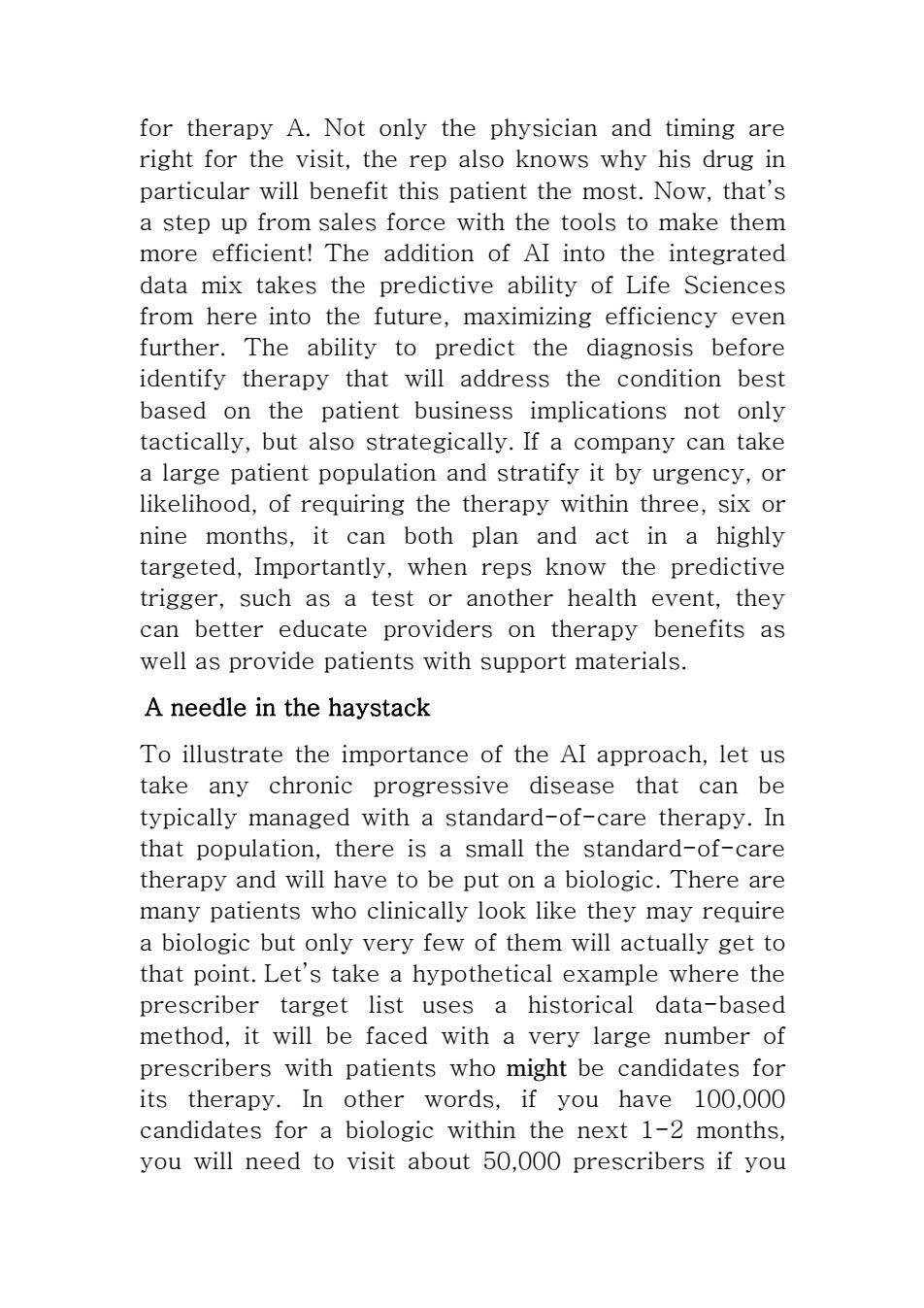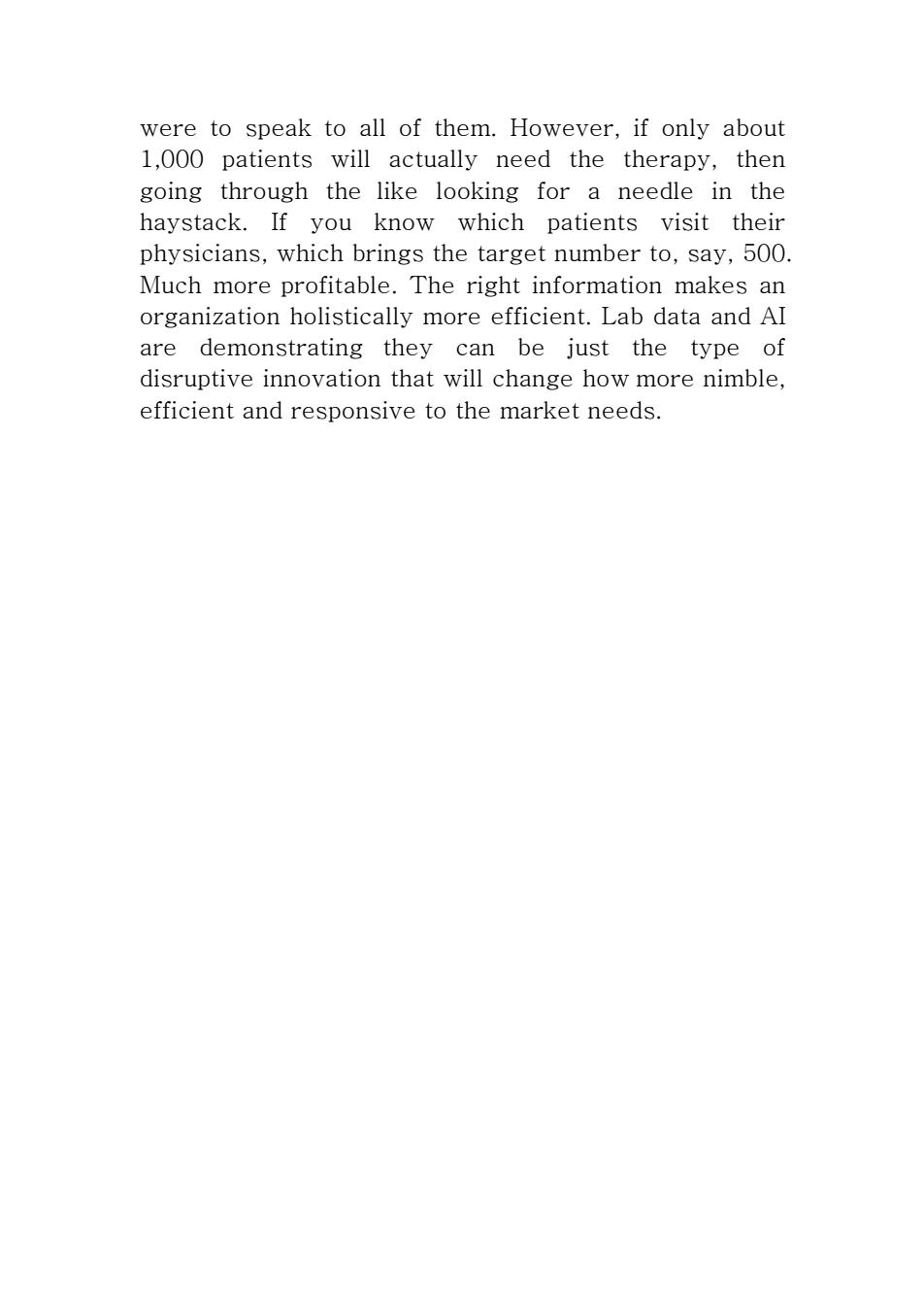
How Al can help Life Sciences find a needle in the haystack Efficiency is all about making the optimal use of your resources.For Life Sciences organizations,efficiency is all about their sales forces reaching the right physician at the right time with the right current tools are woefully inadequate. The tools at hand Life Sciences have traditionally relied on prescription and claims data to learn which physicians had seen the most relevant patients and to identify prescribing patterns.This historic data is incredibly useful strategic planning perspective but it does nothing to help with tactical Retrospective in nature,claims and prescriptions alone show prescribing decisions that have already been made.You don't know if the prescriber has patients that can benefit from your month,you are making an assumption he or she might because they had these patients in the developing the right message for these physicians,sales reps also have to guess as to why a particular therapy was chosen.They have no way of knowing if their assumptions are correct or will resonate with the prescriber's thought process. Downward market pressures
How AI can help Life Sciences find a needle in thehaystack Efficiency is all about making the optimal use of your resources. For Life Sciences organizations, efficiency is all about their sales forces reaching the right physician at the right time with the right current tools are woefully inadequate. The tools at hand Life Sciences have traditionally relied on prescription and claims data to learn which physicians had seen the most relevant patients and to identify prescribing patterns. This historic data is incredibly useful strategic planning perspective but it does nothing to help with tactical Retrospective in nature, claims and prescriptions alone show prescribing decisions that have already been made. You don’t know if the prescriber has patients that can benefit from your month, you are making an assumption he or she might because they had these patients in the developing the right message for these physicians, sales reps also have to guess as to why a particular therapy was chosen. They have no way of knowing if their assumptions are correct or will resonate with the prescriber’s thought process. Downward market pressures

That's a lot of guesswork for the industry looking to increase sales while facing significant downward pressures in the market.Over the past 3-5 years,Life Sciences organizations had to operate in a changing managed care environment.Patients are often restricted access to high physicians have to take multiple administrative steps to demonstrate that a patient should,indeed,be on the therapy they consider the most efficacious.At the same time,some recent highly differentiated drug such as for high cholesterol or chronic heart failure,have not performed as well as expected.Moreover,the size of an average sales team has been shrinking in many companies.Today,you hardly ever see a 5,000 member sales force that can visit every prospective physician every month or quarter.opportunity to speak with physicians has diminished as some adopt a as little as a few minutes- to learn about the treatment options.This means that the time reps do get with prescribers needs to be spent wisely,with the message that will help physicians distract them from it. The game changer:applying AI to clinical lab data So,how do you improve sales reps'efficiency?With diagnostic,or lab,data and Artificial techniques.A lab result is the determining factor in about 70%of prescribing decisions.Used on its own or in combination with claims and prescription records,lab data allows for a de-identified patient patient journey to be mapped out.Clinical lab data indicates -in real time,as soon as the lab test results are ready -how a patient is doing,if he or she needs a specific therapy. This is the first time ever that Life Sciences can know that Dr.Smith currently has a patient who is a great fit
That’s a lot of guesswork for the industry looking to increase sales while facing significant downward pressures in the market. Over the past 3-5 years, Life Sciences organizations had to operate in a changing managed care environment. Patients are often restricted access to high physicians have to take multiple administrative steps to demonstrate that a patient should, indeed, be on the therapy they consider the most efficacious. At the same time, some recent highly differentiated drug such as for high cholesterol or chronic heart failure, have not performed as well as expected. Moreover, the size of an average sales team has been shrinking in many companies. Today, you hardly ever see a 5,000 member sales force that can visit every prospective physician every month or quarter. opportunity to speak with physicians has diminished as some adopt a as little as a few minutes – to learn about the treatment options. This means that the time reps do get with prescribers needs to be spent wisely, with the message that will help physicians distract them from it. The game changer: applying AI to clinical lab data So, how do you improve sales reps’ efficiency? With diagnostic, or lab, data and Artificial techniques. A lab result is the determining factor in about 70% of prescribing decisions. Used on its own or in combination with claims and prescription records, lab data allows for a de-identified patient patient journey to be mapped out. Clinical lab data indicates – in real time, as soon as the lab test results are ready – how a patient is doing, if he or she needs a specific therapy. This is the first time ever that Life Sciences can know that Dr. Smith currently has a patient who is a great fit

for therapy A.Not only the physician and timing are right for the visit,the rep also knows why his drug in particular will benefit this patient the most.Now,that's a step up from sales force with the tools to make them more efficient!The addition of AI into the integrated data mix takes the predictive ability of Life Sciences from here into the future,maximizing efficiency even further.The ability to predict the diagnosis before identify therapy that will address the condition best based on the patient business implications not only tactically,but also strategically.If a company can take a large patient population and stratify it by urgency,or likelihood,of requiring the therapy within three,six or nine months,it can both plan and act in a highly targeted,Importantly,when reps know the predictive trigger,such as a test or another health event,they can better educate providers on therapy benefits as well as provide patients with support materials. A needle in the haystack To illustrate the importance of the Al approach,let us take any chronic progressive disease that can be typically managed with a standard-of-care therapy.In that population,there is a small the standard-of-care therapy and will have to be put on a biologic.There are many patients who clinically look like they may require a biologic but only very few of them will actually get to that point.Let's take a hypothetical example where the prescriber target list uses a historical data-based method,it will be faced with a very large number of prescribers with patients who might be candidates for its therapy.In other words,if you have 100,000 candidates for a biologic within the next 1-2 months, you will need to visit about 50,000 prescribers if you
for therapy A. Not only the physician and timing are right for the visit, the rep also knows why his drug in particular will benefit this patient the most. Now, that’s a step up from sales force with the tools to make them more efficient! The addition of AI into the integrated data mix takes the predictive ability of Life Sciences from here into the future, maximizing efficiency even further. The ability to predict the diagnosis before identify therapy that will address the condition best based on the patient business implications not only tactically, but also strategically. If a company can take a large patient population and stratify it by urgency, or likelihood, of requiring the therapy within three, six or nine months, it can both plan and act in a highly targeted, Importantly, when reps know the predictive trigger, such as a test or another health event, they can better educate providers on therapy benefits as well as provide patients with support materials. A needle in the haystack To illustrate the importance of the AI approach, let us take any chronic progressive disease that can be typically managed with a standard-of-care therapy. In that population, there is a small the standard-of-care therapy and will have to be put on a biologic. There are many patients who clinically look like they may require a biologic but only very few of them will actually get to that point. Let’s take a hypothetical example where the prescriber target list uses a historical data-based method, it will be faced with a very large number of prescribers with patients who might be candidates for its therapy. In other words, if you have 100,000 candidates for a biologic within the next 1-2 months, you will need to visit about 50,000 prescribers if you

were to speak to all of them.However,if only about 1,000 patients will actually need the therapy,then going through the like looking for a needle in the haystack.If you know which patients visit their physicians,which brings the target number to,say,500. Much more profitable.The right information makes an organization holistically more efficient.Lab data and AI are demonstrating they can be just the type of disruptive innovation that will change how more nimble, efficient and responsive to the market needs
were to speak to all of them. However, if only about 1,000 patients will actually need the therapy, then going through the like looking for a needle in the haystack. If you know which patients visit their physicians, which brings the target number to, say, 500. Much more profitable. The right information makes an organization holistically more efficient. Lab data and AI are demonstrating they can be just the type of disruptive innovation that will change how more nimble, efficient and responsive to the market needs